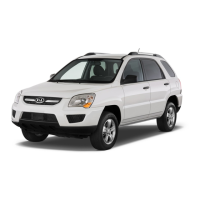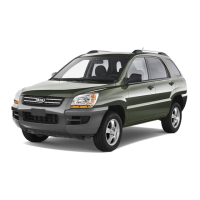
Do you have a question about the Kia Sportage 2013 and is the answer not in the manual?
| Brand | Kia |
|---|---|
| Model | Sportage 2013 |
| Category | Automobile |
| Language | English |
Guide to understanding the manual's layout, sections, and the importance of warnings and cautions for personal safety.
Information on recommended fuel types, including octane ratings and cautions against using certain fuels like E85 or methanol.
Instructions on operating the vehicle correctly to avoid loss of control, accidents, or rollovers due to its design characteristics.
Precautions for the first 1,000 km (600 miles) to ensure optimal engine performance, economy, and longevity.
A guide to understanding various indicator and warning symbols displayed on the instrument cluster for vehicle status.
An overview of the vehicle's interior, identifying key controls and features located within the cabin.
A detailed guide to the instrument panel, identifying the location and function of various controls and indicators.
Identification of major components located in the engine compartment for both MPI and T-GDI engine types.
Information on front and rear seat adjustments, including manual and power seat features, and seat heater functions.
Important safety instructions for seat usage, adjustment, and occupant protection during driving and accidents.
Instructions for manually adjusting front seats, including forward/backward movement, seatback angle, and seat height.
Instructions for operating power front seats, including forward/backward, seatback angle, seat height, and lumbar support adjustments.
Information on adjusting, removing, and active headrest features for occupant safety and comfort.
Instructions for operating the front seat heater, including temperature settings and system notices.
Important warnings and cautions regarding seat heater operation, burn risks, and cleaning of seats.
Instructions for adjusting and folding rear seats, including safety warnings for cargo and occupants.
Important safety guidelines for rear seat belts, cargo securing, and proper seatback usage to prevent injury.
Details on adjusting and reinstalling rear seat headrests for optimal safety and protection in collisions.
Instructions for operating the rear seat heater, including temperature settings and system notices.
Comprehensive information on the vehicle's seat belt system, including restraint principles, safety precautions, and warning indicators.
Crucial safety precautions for seat belt usage, proper restraint, and explanations of the driver's seat belt warning light.
Details on the driver's 3-point seat belt system with emergency locking retractor and how to fasten the belt.
Instructions for adjusting shoulder belt height and critical safety warnings regarding lap belt positioning and seat belt replacement.
Details on the 3-point seat belt system for front passenger and rear seats with combination locking retractors.
Instructions for fastening the rear center seat belt and safety precautions regarding cargo loading and seat belt buckle usage.
Explanation of the pre-tensioner seat belt system, its purpose, operation, and essential safety precautions.
Overview of the Supplemental Restraint System (SRS) components and their functions, including pre-tensioners and control modules.
Important warnings regarding pre-tensioner operation, handling, service, and potential risks of incorrect use.
Comprehensive guide to child restraint systems, including safety precautions, installation procedures, and warnings for various age groups.
Critical safety guidelines for child restraint systems, including advice for infants, larger children, pregnant women, and shoulder belt usage.
Essential safety rules for seat belt usage, care, and precautions, including warnings about reclining seats and folding seatbacks.
Guidelines for periodic inspection, cleaning, and timely replacement of seat belts to ensure safety.
Critical warnings and precautions for correctly installing child restraint systems using anchorage points and seat belts.
Procedure for engaging the auto lock mode on seat belts for child restraints and associated warnings for safe operation.
Detailed steps for securing child restraints with tether anchors and critical warnings about anchorage and tether strap safety.
Essential checks for child restraint system security and warnings regarding the proper use of LATCH anchorages.
Critical warnings regarding the proper use of LATCH lower anchors, including limitations and potential risks of misuse.
Comprehensive information on the vehicle's air bag system, including types, operation, safety precautions, and warnings.
Essential safety warning emphasizing the importance of wearing seat belts even with air bags to minimize injury risk in collisions.
Explanation of how the air bag system operates, including inflation speed, potential injuries, and critical safety warnings for occupant positioning.
Critical warnings about hot air bag components after deployment and the severe hazard of placing child restraints in the front passenger seat.
Information on side impact air bags and critical safety warnings about placing child restraints in front seats due to air bag deployment risks.
Specific safety warnings regarding side impact air bags, accessory placement, seat covers, and sensor impact.
Information on curtain air bags, their deployment in side impacts and rollovers, and essential safety precautions for occupants and children.
Details on air bag collision sensors and critical warnings about avoiding impacts or objects near sensor locations to prevent accidental deployment.
Critical warnings about avoiding impacts or alterations to air bag sensors and the risks associated with using non-genuine parts.
Explanation of conditions under which air bags may not deploy, including low-speed collisions and specific impact types.
Essential guidelines for SRS system care, including warnings about modifications, servicing, and potential risks of improper handling or repair.
Crucial safety precautions for occupants, including proper seating posture, seat belt usage, and warnings related to air bag proximity and vehicle movement.
Important warnings about modifying the air bag system, including the risks of affecting operation, causing injury, or voiding warranties.
Information about the vehicle's keys, including types, operations, and recording the key number for duplication.
Instructions for key operations like unfolding/folding and removing the mechanical key, plus advice on recording your key number.
Explanation of the immobilizer system, its activation, and critical safety warnings regarding ignition key security and unattended vehicles.
Cautions regarding the immobilizer system, including avoiding metal accessories near the ignition switch and not altering the system.
Step-by-step procedure for starting the engine using the limp home override function when the key is not recognized.
Detailed instructions for operating the remote keyless entry system, including locking, unlocking, and alarm functions.
Detailed instructions for operating the remote keyless entry system, including locking, unlocking, and alarm functions.
Precautions for transmitter operation, including warnings about interference, water exposure, and instructions for battery replacement.
Cautions regarding the keyless entry system, including potential malfunctions due to moisture, static electricity, or incorrect battery usage.
Comprehensive guide to the smart key system, covering its functions, operations, and security features.
Detailed instructions for operating the smart key functions: locking, unlocking, tailgate operation, and alarm activation.
Instructions for locking and unlocking vehicle doors and tailgate using the smart key, including operational notes and cautions.
Instructions for starting the engine with the smart key and important precautions regarding key loss, theft prevention, and system limitations.
Step-by-step guide for replacing the smart key battery, including important notices and cautions regarding battery handling and disposal.
Explanation of the theft-alarm system, its stages of operation, and procedures for arming, disarming, and responding to alarms.
Instructions for arming the theft-alarm system, including stages of operation and critical safety precautions regarding passenger presence and system deactivation.
Details on the theft-alarm stage activation and disarming procedures, including cautions about system alterations and starting the engine during alarm.
Information on the vehicle's door lock system, including operation from outside and inside the vehicle, and associated safety warnings.
Instructions for operating door locks from outside the vehicle using the key or transmitter, including methods to lock doors without the key and essential safety warnings.
Instructions for operating door locks from inside the vehicle using the door lock button and critical warnings for door lock system malfunctions.
Details on using the central door lock switch and critical safety warnings regarding door security, proper closing, and potential hazards when opening doors.
Explanation of impact sensing, auto door lock/unlock features, and critical warnings about vehicle security and unattended children.
Details on the child-protector rear door lock system and critical safety warnings to prevent children from accidentally opening rear doors.
Information on tailgate operation, including opening, closing, and safety precautions related to tailgate movement.
Instructions for opening and closing the tailgate, including critical safety warnings regarding tailgate movement and latching.
Information on the emergency tailgate safety release and critical safety warnings regarding cargo area usage and potential exhaust fume intrusion.
Details on the vehicle's power window system, including operation, features, and safety precautions.
Instructions for operating power windows, including opening, closing, and auto down features, with notices about driving conditions.
Details on auto up/down window operation, automatic reversal functions, and critical warnings about checking for obstructions before raising windows.
Instructions for using the power window lock button and critical safety warnings regarding children playing with power windows and extending limbs outside the vehicle.
Instructions for opening and closing the vehicle hood, including safety warnings about hot engine parts and engine operation.
Step-by-step instructions for opening the vehicle hood, including critical safety warnings about hot engine parts and engine operation.
Instructions for closing the vehicle hood and critical safety warnings regarding obstructions, flammable materials, and ensuring the hood is securely latched.
Information on operating the fuel filler lid and critical safety warnings for refueling, including risks of fuel spray and proper cap installation.
Instructions for opening the fuel filler lid and critical safety warnings for refueling, including risks of fuel spray, pressure, and proper cap installation.
Critical warnings and guidelines for safe refueling practices, including preventing static discharge, avoiding cellular phones, and shutting off the engine.
Details on operating the panoramic sunroof, including opening, closing, sliding, tilting, and associated safety warnings.
Information on the sunroof open warning chime and cautions regarding secure sunroof closure to prevent interior damage and theft.
Instructions for sliding the sunroof, including warnings against adjusting while driving and cautions about roller blind operation.
Instructions for resetting the sunroof system after battery disconnection and critical safety warnings regarding sunroof operation and closure.
Information on the vehicle's steering wheel, including electric power steering system and operational cautions.
Explanation of the electric power steering system, its operation, and cautions regarding potential malfunctions and warning lights.
Instructions for adjusting tilt and telescope steering, and operating the heated steering wheel, including critical safety warnings.
Instructions for operating the steering wheel horn and cautions regarding aftermarket grips, cleaning, and potential damage to heated steering wheel components.
Details on rearview mirror adjustment, including inside, day/night, and electrochromic mirrors, with related safety warnings.
Instructions for adjusting the inside rearview mirror and critical safety warnings regarding rear visibility, mirror adjustment, and modifications.
Explanation of the Electrochromic Mirror (ECM) operation for automatic glare control and cautions regarding window tint interference.
Information on the HomeLink system for garage door/gate operation, including programming steps and critical safety warnings related to potential hazards during operation.
Instructions for programming and erasing HomeLink buttons for garage door openers and other rolling code devices.
Detailed instructions for rolling code programming and operating the HomeLink system for various devices like garage doors and lighting.
Instructions for reprogramming single HomeLink buttons and information about available accessories and compatibility.
Instructions for adjusting and folding outside rearview mirrors, including critical safety warnings regarding rear visibility, mirror adjustment, and potential hazards.
Instructions for folding the outside rearview mirror and cautions regarding motor operation, manual adjustment, and potential damage to mirror parts.
Overview of the instrument cluster, including its components, gauges, and warning/indicator lights.
Overview of the instrument cluster components, including tachometer, speedometer, gauges, and various warning and indicator lights.
Instructions for adjusting instrument panel illumination and explanations of the speedometer and tachometer gauges.
Explanation of the engine temperature gauge operation and critical warnings regarding overheating and radiator cap removal.
Explanation of the fuel gauge operation, low fuel warning, and functions of the odometer, tripmeter, and trip computer.
Details on the odometer and tripmeter functions, including how to track distances and perform maintenance reminders.
Explanation of fuel consumption displays, including distance to empty, average fuel consumption, and instant fuel consumption.
Details on displaying average vehicle speed and total driving time, including reset procedures and operational notices.
Information on the outside thermometer display and the ECOMINDER system for optimizing fuel efficiency, including ON/OFF mode operation.
Critical safety warning about the ECOMINDER indicator and explanation of the air bag warning light function and potential malfunctions.
Explanation of ABS, EBD, and seat belt warning lights, including their meaning, potential malfunctions, and critical safety warnings related to brake system issues.
Explanation of the engine oil pressure warning light and critical cautions regarding potential engine damage from low oil pressure.
Explanation of parking brake, brake fluid, and shift pattern indicators, with critical safety warnings for driving with warning lights illuminated.
Explanation of charging system, low fuel level, and electric power steering (EPS) warning lights, including their meaning and potential causes.
Explanation of the immobilizer indicator and the Malfunction Indicator Light (MIL), including their purpose and cautions regarding potential engine damage.
Explanation of ESC and DBC indicator lights, their operation, and critical safety warnings regarding driving conditions and tire/wheel compatibility.
Explanation of cruise control indicators, key reminder warning chime, and the 4WD system warning light.
Explanation of the 4WD LOCK indicator and various LCD display warnings related to smart key, engine start, and low key battery.
Details on LCD display warnings related to key insertion, shift lever position, stop lamp fuse, and low washer fluid levels.
Information on the rear parking assist system, including its operation, limitations, and critical safety warnings.
Explanation of the rear parking assist system's operation, activation conditions, and critical safety warnings regarding its limitations and driver responsibility.
Details on conditions that may cause the rear parking assist system to malfunction and a list of objects that may not be recognized by the sensors.
Important precautions for the rear parking assist system, including self-diagnosis procedures and critical warnings about vehicle warranty and driver awareness.
Information on the rearview camera system, its operation, and critical safety warnings regarding camera limitations.
Critical safety warnings about rearview camera limitations, including dead zones, lens cleanliness, and the driver's responsibility for checking areas.
Instructions for using the hazard warning flasher, including when to use it, how to activate it, and its operating conditions.
Instructions for using the hazard warning flasher, including when to use it, how to activate it, and its operating conditions.
Details on the vehicle's lighting system, including battery saver function, headlight escort, and welcome functions.
Explanation of the battery saver function, headlight escort, and headlight welcome features, including operational instructions and cautions.
Instructions for operating the vehicle's lighting system, including parking lights, headlights, and auto light positions.
Instructions for operating the auto light system and high beam headlights, including cautions about sensor placement and warnings against improper high beam usage.
Instructions for using turn signals and lane change signals, including self-cancel features and troubleshooting for bulb issues.
Information on front fog light usage for improved visibility and explanation of daytime running lights (DRL) for enhanced vehicle visibility.
Detailed information on the operation of windshield and rear window wipers and washers, including speed controls and cautions.
Instructions for operating windshield and rear window wipers and washers, including descriptions of speed controls and notices about driving conditions.
Details on auto sunroof operation and reversal, with cautions regarding sensor cleaning and operation in winter conditions.
Overview of the vehicle's interior features, including interior lighting, map lamps, and storage compartments.
Explanation of interior lighting functions, including room lamp operation based on door status and ignition position, and cautions about battery discharge.
Instructions for operating the map lamp, including its spot beam functionality and cautions regarding battery usage and vision obstruction.
Explanation of the interior light welcome function, detailing how room lamps activate based on door status or smart key operations.
Information on the luggage room lamp operation when the tailgate is opened.
Instructions for the glove box lamp, noting its operation requires parking lights or headlights to be ON.
Details on operating the vanity mirror lamps, including their function and a notice about turning them off before returning the sun visor.
Overview of the vehicle's storage compartments, including center console and glove box, with related cautions and warnings.
Instructions for opening and using the center console storage compartment, with warnings about flammable materials and theft prevention.
Instructions for opening and closing the glove box, with warnings about storing food and reducing injury risk from sudden stops.
Instructions for using the glove box cooling feature, including how to operate the vent lever and notices about condensed moisture.
Instructions for opening and closing the sunglass holder, with warnings about objects inside and opening the holder while driving.
Instructions for using the cargo security screen to hide items, with cautions about carrying fragile objects and warnings about stretching the luggage net.
Instructions for using luggage net holders in the cargo area to secure items and prevent shifting, with cautions about carrying fragile objects.
Overview of the vehicle's exterior features, including roof rack usage, and related cautions and warnings.
Instructions for using the roof rack to load cargo, including cautions about cargo placement and warnings about vehicle center of gravity and driving conditions.
Information about the vehicle's audio system, including antenna usage and notice about aftermarket HID headlamps.
Details about the vehicle's removable roof antenna, including installation, removal, and cautions regarding low height clearance and car washes.
Instructions for operating the radio, setup menu, volume control, and audio controls on the steering wheel.
Information on connecting portable audio devices via Aux, USB, and iPod ports, including notices and cautions regarding device compatibility and usage.
Explanation of how AM and FM radio signals are received and processed by the vehicle's audio system, including factors affecting reception quality.
Instructions for using the USB device with the audio system, including file playback modes, folder navigation, and information display.
Critical cautions regarding the use of external USB devices with the vehicle's audio system, including potential damage and compatibility issues.
Critical cautions regarding the use of iPod devices with the vehicle's audio system, including compatibility, connection, and potential issues.
Instructions for using iPod devices with the vehicle's audio system, including playback modes, folder navigation, and menu functions.
Information on SIRIUS satellite radio channels, reception factors, service details, and electronic serial number (ESN).
Instructions for activating and using SIRIUS Satellite Radio, including channel selection, category list mode, and scan features.
Comprehensive guide to Bluetooth phone operation, including general features, receiving calls, talking, and voice recognition.
Instructions for setting up the Bluetooth phone system, including pairing phones, changing priority, and deleting paired phones.
Explanation of Bluetooth audio music streaming capabilities, including supported profiles, playback procedures, and notes on phone compatibility.
Pre-driving checks for vehicle cleanliness, tire condition, fluid levels, and ensuring no obstacles are present.
Guidance on regularly checking fluid levels such as engine oil, coolant, brake fluid, and washer fluid.
Pre-start checks including closing doors, adjusting seat, mirrors, checking gauges, and verifying warning lights.
Critical warnings about the dangers of driving under the influence of alcohol or drugs, emphasizing the increased risk of accidents and injury.
Explanation of the ignition switch positions (LOCK, ACC, ON, START) and their functions, including warnings about illuminated ignition switches.
Details on the ignition switch positions: LOCK, ACC, and START, including steering wheel lock and key removal procedures.
Information about the illuminated ignition switch feature and its operation when doors are opened or closed.
Explanation of the engine start/stop button operation, including its positions (OFF, ACC, ON, START) and associated warnings.
Instructions for operating the engine start/stop button with automatic transaxle, covering engine off, ACC, ON, and START positions.
Caution regarding turning off the engine or vehicle power only when the vehicle is not in motion, and emergency procedures.
Step-by-step instructions for starting the engine, including procedures for manual and automatic transaxles, and warnings about proper footwear and operation.
Cautions regarding engine stalling while driving, including procedures for restarting and avoiding damage to the starter.
Warning about the engine starting only when the smart key is in the vehicle and cautions against allowing children or unfamiliar persons to touch related parts.
Caution regarding engine stalling while driving, including procedures for restarting and avoiding damage to the starter.
Information on the manual transaxle operation, including shift patterns, clutch usage, and cautions regarding downshifting and engine damage.
Detailed instructions for operating the manual transaxle, including shift patterns, clutch usage, and cautions regarding downshifting and engine damage.
Cautions regarding downshifting from high gears at high speeds, and avoiding drastic downshifts to prevent engine damage.
Instructions for using the clutch pedal properly, including warnings about resting foot on pedal, engaging clutch on inclines, and operating clutch rapidly.
Guidance on proper downshifting techniques for slowing down, driving uphill, and maintaining safe speed, including warnings about vehicle movement.
Essential driving practices for safe operation, including avoiding coasting, riding brakes, and abrupt maneuvers.
Critical warnings about buckling up, avoiding high speeds in turns, sharp steering movements, and the risk of rollover.
Advice on cornering techniques, especially on wet roads, to maintain traction and minimize tire wear.
Important tips for safe night driving, including adjusting mirrors, cleaning headlights, and avoiding direct stares at oncoming headlights.
Warning about the dangers of spinning tires at high speeds, including potential tire damage and injury to bystanders.
Warning about the risks of rocking a stuck vehicle, emphasizing safety precautions for people and objects near the vehicle.
Critical warnings about the higher rollover risk of SUVs, emphasizing the importance of seat belts and avoiding sharp turns or abrupt maneuvers.
Information on four-wheel drive (4WD) operation, including its benefits, limitations, and safe driving practices.
Explanation of the tight corner brake effect in four-wheel drive vehicles and cautions regarding sharp turns at low speeds.
Details on the different 4WD transfer modes (AUTO, LOCK), their selection buttons, indicator lights, and descriptions.
Essential guidelines for safe four-wheel drive operation, including warnings about driving in deep water, mud, steep hills, and slippery surfaces.
Critical warnings about the stresses on the vehicle during four-wheel drive operation and the importance of driver alertness and reduced speeds.
Critical warnings about the extreme danger of driving across steep hills, emphasizing the risk of destabilization, rollover, and serious injury.
Critical warnings regarding steering wheel grip and maneuvers when driving off-road to prevent loss of control and injury.
Warning about the effect of heavy wind on vehicle steering control and the need to drive more slowly.
Warning about driving through water, emphasizing slow speeds, adequate stopping distance, and potential engine damage.
Warning about the dangers of spinning tires at high speeds, including potential tire damage and injury to bystanders.
Comprehensive information on the vehicle's brake system, including power brakes, brake failure procedures, and parking brake operation.
Explanation of power-assisted brakes, procedures for stopping when power assist is interrupted, and warnings about brake usage.
Procedures for making an emergency stop if service brakes fail, emphasizing the use of the parking brake and greater stopping distance.
Critical warnings about resting foot on brake pedal, abnormal brake temperatures, and increased stopping distances.
Critical warnings about applying the parking brake while moving and using it only in emergencies to avoid loss of control and injury.
Caution regarding operating the parking brake while the vehicle is moving, except in emergencies, to prevent vehicle damage and safety hazards.
Explanation of the disc brake wear indicator, its function, and warnings about driving with worn brake pads.
Instructions for applying and releasing the parking brake (foot and hand types), including recommendations for parking on gradients.
Warning that brake wear sounds indicate service is needed, and ignoring them can lead to loss of braking performance and accidents.
Cautions to avoid costly brake repairs by not driving with worn brake pads and replacing them in pairs.
Caution that driving with the parking brake applied causes excessive wear and potential damage.
Explanation of the Anti-lock Brake System (ABS), its operation, and warnings regarding driving maneuvers and conditions.
Critical warnings about ABS limitations, emphasizing safe driving distances, reduced speeds in adverse conditions, and avoiding testing ABS capabilities.
Explanation of the Electronic Stability Control (ESC) system, its purpose in stabilizing the vehicle during cornering, and operation.
Caution regarding driving on poor traction surfaces and the importance of maintaining safe speeds and driver attentiveness.
Critical warning that Electronic Stability Control (ESC) is a driving aid, not a substitute for safe driving practices, and emphasizes avoiding excessive speed and maneuvers.
Instructions for turning the ESC system off and on, including warnings about potential vehicle slip if ESC is deactivated during operation.
Explanation of the Vehicle Stability Management (VSM) system, its enhancements to stability and steering, and its operation and malfunction indicators.
Explanation of the Hill-start Assist Control (HAC) system, its function in preventing rollback on hills, and operational notices.
Warning that HAC is activated only for about 2 seconds, emphasizing the need for accelerator input when starting off.
Explanation of the Downhill Brake Control (DBC) system, its function in supporting downhill driving, and on/off operation.
Tips for improving fuel economy and reducing maintenance costs, including suggestions for smooth driving, tire care, and vehicle condition.
Critical warning against turning the engine off while driving, emphasizing the loss of power steering and brakes, and potential steering lock.
Guidance on driving in hazardous conditions such as water, snow, ice, mud, sand, and advice on reducing the risk of vehicle rollover.
Suggestions for driving in hazardous conditions like water, snow, ice, mud, and sand, including driving cautiously and avoiding sudden maneuvers.
Warning about the risks of downshifting with automatic transaxle on slippery surfaces, emphasizing potential skids and loss of control.
Warning about not pumping the brake pedal on vehicles equipped with ABS, and the potential consequences of incorrect brake application.
Information on the higher rollover risk of SUVs and recommendations to reduce this risk, including seat belt usage and avoiding sharp turns.
Advice on cornering techniques, especially on wet roads, to maintain traction and minimize tire wear.
Important tips for safe night driving, including adjusting mirrors, cleaning headlights, and avoiding direct stares at oncoming headlights.
Warning about the dangers of spinning tires at high speeds, including potential tire damage and injury to bystanders.
Warning about the risks of rocking a stuck vehicle, emphasizing safety precautions for people and objects near the vehicle.
Critical warnings about the higher rollover risk of SUVs, emphasizing the importance of seat belts and avoiding sharp turns or abrupt maneuvers.
Tips for driving safely in rain and wet conditions, including maintaining safe distances, windshield wiper care, and brake drying.
Advice on driving through flooded areas, emphasizing slow speeds, adequate stopping distance, and brake performance.
Guidance on highway driving, focusing on tire care, inflation pressures, load limits, and warnings about tire condition and replacement.
Information on tire care, including inflation pressures, load limits, and warnings about underinflated or overinflated tires.
Guidelines for driving safely in winter conditions, including advice for snowy/icy conditions, snow tires, and radial-ply tires.
Advice for driving in snowy or icy conditions, including recommendations for snow tires, engine braking, and maintaining safe distances.
Information on selecting and using snow tires, including size, load range, air pressure, and speed limitations.
Warning about the importance of using correct snow tire sizes and types to maintain vehicle handling and safety.
Comprehensive guide to trailer towing, including legal requirements, equipment, safety rules, and vehicle capacity considerations.
Important points to consider before towing a trailer, including sway control, break-in period, hitch equipment, and speed limits.
Critical warnings about adhering to trailer weight limits, including total trailer weight, GCW, GVW, GAW, and trailer tongue load.
Caution that pulling a trailer improperly can cause vehicle damage and costly repairs not covered by warranty.
Critical warning about losing control when towing a trailer due to incorrect equipment or improper driving, emphasizing the risk of serious injury or death.
Information on hitch equipment, including rules for installation, sealing holes to prevent CO intrusion, and using approved trailer hitches.
Instructions for attaching safety chains between the vehicle and trailer, including proper crossing and slack adjustment.
Information on trailer brake systems, including regulations, proper installation, and adjustment, with warnings for amateur work.
Critical warning about ensuring proper setup of trailer brake systems, emphasizing that this is not a task for amateurs and recommending professional help.
Information on turn signal operation when towing a trailer, including the need for extra wiring and checking trailer bulb functionality.
Warning about the potential damage to the vehicle electrical system and personal injury from using an unapproved trailer wiring harness.
Guidance on driving on grades, including reducing speed, shifting to lower gears for engine braking, and managing engine/transaxle temperature.
Instructions for parking on hills, including wheel direction, gear selection, parking brake engagement, and using chocks.
Critical warning about the severe injury or death risk if children accidentally open rear doors or if the trailer breaks loose.
Critical warning about the danger of leaving the vehicle with the parking brake not fully engaged, emphasizing the risk of unintended movement and injury.
Caution against using the accelerator pedal to hold the vehicle on an incline, as it can cause transaxle overheating.
Guidance on increased maintenance needs when towing a trailer, highlighting items like engine oil, transaxle fluid, and brake condition.
Cautions regarding potential overheating during trailer usage and the importance of checking transaxle fluid more frequently.
Important points to consider before towing a trailer, including sway control, break-in period, hitch equipment, and speed limits.
Information on vehicle load limits, including tire and loading labels, seating capacity, and vehicle capacity weight.
Explanation of the tire and loading information label found on the driver's door sill, detailing tire size, pressures, and vehicle capacity.
Definition of vehicle capacity weight as the maximum combined weight of occupants and cargo, including tongue load if applicable.
Information on the vehicle's seating capacity, including front and rear seat limits, and how occupant and cargo weight affects it.
Details on the vehicle's towing capacity with and without trailer brakes, and the maximum trailer weight that can be towed.
Explanation of cargo capacity, noting how weight and number of occupants affect it, and the importance of load distribution.
Step-by-step guide to determining the correct load limit by calculating available cargo and luggage load capacity.
Critical warnings about the dangers of overloading the vehicle, including risks of accidents, vehicle damage, and shortened component life.
Critical warnings about securing cargo inside the vehicle to prevent occupant injury during sudden stops, turns, or crashes.
Cautions regarding vehicle overloading, potential damage, and the importance of using correct loading procedures.
Information on hazard warning flashers, their operation, usage, and precautions, including when the vehicle is stopped or being towed.
Instructions for using the hazard warning flasher, including when to use it, how to activate it, and its operating conditions.
Guidance on actions to take in emergency situations while driving, including engine stalls and flat tires.
Procedure for handling engine stalls at crossroads or crossings, including shifting to neutral and moving the vehicle to a safe place.
Step-by-step instructions for handling a flat tire while driving, emphasizing gradual slowdown, careful braking, and safe pull-off.
Troubleshooting guide for situations where the engine will not start or turns over slowly, including checks for fuel, battery, and starter connections.
Checks to perform when the engine doesn't turn over or turns over slowly, including battery connections and starter checks.
Troubleshooting steps when the engine turns over normally but does not start, including fuel level checks and connector inspections.
Critical warning against push or pull starting the vehicle, highlighting risks of collision, damage, and fire hazards.
Detailed instructions for jump starting a vehicle, including safety precautions, warnings about battery hazards, and procedures for connecting/disconnecting cables.
Step-by-step procedure for jump starting a vehicle, emphasizing safety precautions to avoid harm, damage, and explosions.
Critical warnings about battery hazards, including keeping flames away, avoiding contact with acid, and proper ventilation.
Warning about the dangers of battery rupture or explosion if electrolyte level is low or if cables are connected incorrectly.
Caution regarding the use of unauthorized jumper systems or 24-volt power supplies, which can damage vehicle components.
Note that push-starting is not possible for vehicles with automatic transaxle or clutch lock systems.
Caution regarding battery cable connections, emphasizing avoiding incorrect terminal connections and leaning over the battery.
Warning against towing a vehicle to start it, as sudden forward surge can cause collisions.
Procedures to follow if the engine overheats, including pulling over safely, checking coolant, and seeking professional assistance.
Procedures to follow if the engine overheats, including pulling over safely, checking coolant, and seeking professional assistance.
Warning to keep hands and clothing away from moving engine parts like the fan and drive belts to prevent injury.
Critical warning about not removing the radiator cap when the engine is hot due to pressurized coolant and steam.
Caution that serious loss of coolant indicates a leak that requires immediate inspection by an authorized Kia dealer.
Instructions for changing a flat tire, including locating the jack and tools, and safety warnings for tire changing.
Identification and storage location of the jack, jack handle, wheel lug nut wrench, and spare tire.
Critical warnings about changing tires in traffic lanes, emphasizing safe parking, firm ground, and using correct jacking positions.
Instructions for removing and storing the spare tire and tools properly to prevent rattling while the vehicle is in motion.
Step-by-step instructions for changing tires, including parking brake application, shift lever position, and hazard warning flasher activation.
Critical warnings about preventing vehicle movement while changing a tire, emphasizing parking brake and wheel blocking.
Critical warning about the correct jack location and the possibility of injury from using incorrect jack support points.
Warnings about wheel edges, hub contact, and tire failure due to improper installation or wear, emphasizing the risk of loss of control and injury.
Comprehensive guide to towing the vehicle, including procedures for 4WD and 2WD vehicles, and warnings related to towing equipment and air bag deployment.
Recommendations for using authorized Kia dealer or commercial tow truck services for emergency towing, emphasizing proper lifting and towing procedures.
Caution that 4WD vehicles should never be towed with wheels on the ground, as it can cause serious damage to the transaxle or 4WD system.
Warning regarding side and curtain air bag deployment during towing if the ignition is ON and rollover sensor detects a rollover situation.
Procedure for emergency towing without wheel dollies, including ignition switch position, shift lever, parking brake, and steering.
Instructions for removing and installing the removable towing hook, including cautions about its proper use.
Caution that failing to place the transaxle shift lever in Neutral may cause internal damage.
Cautions regarding towing the vehicle backwards with front wheels on the ground and using sling-type equipment.
Recommendations for emergency towing procedures, including the use of towing straps, communication between drivers, and caution during towing.
Cautions about attaching towing straps, using proper equipment, and avoiding jerking or pulling the hook from the side.
Extreme caution warnings for towing, including risks of sudden starts, erratic maneuvers, disabling the vehicle, and potential injury.
Precautions for emergency towing, including ignition switch position, shift lever, parking brake, brake performance, steering effort, and engine cooling.
Caution regarding towing vehicles with automatic transaxle, emphasizing speed limits, fluid checks, and potential damage from improper towing.
Warning about the improper use of tie-down hooks for towing purposes, emphasizing that they are designed only for transport tie-down and can cause injury if misused.
This is a Table of Contents entry, ignore.
This is a Table of Contents entry, ignore.
This is a Table of Contents entry, ignore.
This is a Table of Contents entry, ignore.
This is a Table of Contents entry, ignore.
This is a Table of Contents entry, ignore.
This is a Table of Contents entry, ignore.
This is a Table of Contents entry, ignore.
This is a Table of Contents entry, ignore.
This is a Table of Contents entry, ignore.
This is a Table of Contents entry, ignore.
This is a Table of Contents entry, ignore.
This is a Table of Contents entry, ignore.
This is a Table of Contents entry, ignore.
This is a Table of Contents entry, ignore.
This is a Table of Contents entry, ignore.
This is a Table of Contents entry, ignore.
This is a Table of Contents entry, ignore.
Identification of major components located in the engine compartment for both MPI and T-GDI engine types.
Guidelines for proper vehicle maintenance, emphasizing owner responsibility and the benefits of using authorized Kia dealers.
Information on the owner's responsibility for vehicle maintenance records, warranty compliance, and the importance of proper servicing.
Precautions for owner maintenance, highlighting easy-to-perform tasks and the importance of consulting authorized dealers for complex procedures.
Lists vehicle checks and inspections for owners, including frequencies and general cautions for performing maintenance work.
Routine checks to perform when stopping for fuel, including checking engine oil, coolant, washer fluid levels, and tire pressure.
Critical warnings about the dangers of performing vehicle maintenance, emphasizing the need for knowledge, proper tools, and qualified assistance.
Checks to perform while operating the vehicle, including noting changes in sounds, vibrations, steering, and fluid levels.
Monthly maintenance checks, including coolant level, exterior lights operation, tire inflation pressure, and wiper/washer operation.
Semi-annual maintenance checks, including hoses, windshield wipers, headlight alignment, exhaust system, seat belts, and tire/wheel checks.
Schedule for normal maintenance services, detailing items, intervals, and driving conditions for proper vehicle upkeep.
Continuation of the normal maintenance schedule, detailing items like vacuum hoses, spark plugs, and drive belts with replacement intervals.
Continuation of the normal maintenance schedule, detailing fluids, belts, and chassis components with inspection and replacement intervals.
List of maintenance items requiring more frequent service for vehicles used under severe driving conditions, with intervals and driving conditions.
Explanation of scheduled maintenance items, including engine oil, drive belts, fuel filter, fuel lines, vapor hose, and air cleaner filter.
Information on engine oil and filter changes, emphasizing the need for frequent changes under severe driving conditions.
Instructions for inspecting drive belts for wear, cracks, or oil saturation, and checking their tension.
Explanation of fuel filter function, potential issues with clogged filters, and the need for frequent replacement under certain conditions.
Instructions for checking fuel lines, hoses, and connections for leaks or damage, and the need for immediate replacement of damaged parts.
Information on inspecting the vapor hose and fuel filler cap at specified intervals and ensuring correct replacement.
Instructions for inspecting vacuum hoses for signs of heat or mechanical damage, and ensuring hose connections are secure.
Recommendation for using genuine Kia air cleaner filters and the need for more frequent inspection/replacement in dusty conditions.
Instructions for checking the engine oil level, including procedures for ensuring accuracy and cautions regarding overfilling or spilling oil.
Step-by-step instructions for checking the engine oil level on level ground after the engine has reached normal operating temperature.
Warning to exercise extreme caution when touching radiator hoses, as they can be hot enough to cause burns.
Cautions regarding overfilling engine oil and spilling oil during addition or change, emphasizing potential engine damage.
Recommendation to have engine oil and filter changed by an authorized Kia dealer according to the maintenance schedule.
Warning about used engine oil potentially causing skin irritation or cancer, and the importance of washing hands thoroughly after handling.
Information on the vehicle's high-pressure cooling system, including coolant type, checking level, and warnings regarding radiator cap removal.
Instructions for checking the coolant level and warnings about removing the radiator cap when the engine is hot.
Critical warnings about not using radiator coolant in the washer fluid reservoir and the risks associated with radiator coolant exposure.
Caution regarding refilling coolant, emphasizing the use of a thick cloth and proper handling to prevent coolant overflow.
Instructions for checking brake/clutch fluid level, including periodic checks, reservoir cleaning, and using specified fluid types.
Instructions for checking brake/clutch fluid level, including periodic checks, reservoir cleaning, and using specified fluid types.
Critical warnings about handling brake/clutch fluid, emphasizing eye protection, immediate flushing, and doctor examination if contact occurs.
Cautions about brake/clutch fluid contacting vehicle paint, using extended-exposed fluid, or using incorrect fluid types.
Instructions for checking and filling the washer fluid reservoir, including recommendations for cold climates and warnings about fluid properties.
Instructions for checking and filling the washer fluid reservoir, including recommendations for cold climates and warnings about fluid properties.
Information on the parking brake system, including checking stroke specification and warnings about applying the brake while moving.
Instructions for checking the parking brake stroke and ensuring it securely holds the vehicle on a grade.
Instructions for air cleaner filter inspection and replacement, including cautions about driving without the filter and using genuine parts.
Instructions for air cleaner filter replacement according to the maintenance schedule and cautions regarding dust entry and part damage.
Cautions about driving without the air cleaner element, dust entry into the intake, and using non-genuine parts.
Information on climate control air filter inspection and replacement, emphasizing frequency based on driving conditions.
Instructions for inspecting the climate control air filter, noting replacement frequency based on driving conditions and potential damage during replacement.
Information on wiper blade inspection and replacement, including cautions about cleaning methods and using specified blade types.
Guidelines for inspecting wiper blades for contamination and cleaning them, with notices about commercial car wash waxes.
Instructions for replacing worn or cracked wiper blades, including cautions about using gasoline or solvents, and manual wiper arm movement.
Cautions about using gasoline or solvents on wiper blades and about manual movement of wiper arms.
Caution that using non-specified wiper blades may lead to malfunction or failure.
Instructions for replacing the front windshield wiper blade, including raising the wiper arm and sliding the blade assembly.
Caution about not allowing the wiper arm to fall against the windshield, as it may chip or crack the glass.
Instructions for replacing the rear window wiper blade, including raising the arm and inserting the new blade assembly.
Comprehensive information on battery maintenance, including safety precautions, recharging procedures, and warnings about battery hazards.
Tips for ensuring optimal battery service, including keeping it mounted, clean, and dry, and disconnecting cables for extended storage.
Critical warnings about battery hazards, including keeping flames away, avoiding contact with acid, and proper ventilation.
Instructions for recharging the vehicle's maintenance-free battery, including slow and fast charging procedures and safety precautions.
Critical warnings regarding battery recharging, emphasizing removal from the vehicle, ventilation, avoiding sparks, and proper disconnection order.
Caution against connecting unauthorized electronic devices to the battery, as it may cause discharge.
List of items that require resetting after battery discharge or disconnection, including auto window, sunroof, trip computer, climate control, clock, and audio.
Warnings about turning off accessories and stopping the engine before maintenance or recharging, and proper battery cable handling.
Comprehensive guide to tire care, including inflation pressures, load limits, tire rotation, wheel alignment, and tire replacement.
Guidance on tire care for proper maintenance, safety, and maximum fuel economy, emphasizing tire inflation pressures and load limits.
Information on recommended cold tire inflation pressures, including where to find the label and warnings about underinflation and overinflation.
Critical warning about severe underinflation leading to heat buildup, blowouts, loss of control, and potential injury or death.
Instructions for checking tire inflation pressure monthly, including using a quality gauge and checking the spare tire.
Cautions regarding tire pressure checks, including checking cold pressure, avoiding overloading, and replacing worn tires.
Cautions about warm tires exceeding cold pressure, releasing air from warm tires, and reinstalling valve caps.
Critical warning that overinflation or underinflation can reduce tire life, affect handling, and lead to sudden tire failure.
Recommendations for tire rotation to equalize tread wear, including checking tire balance and inspecting for wear or damage.
Information on tire maintenance, including wheel alignment for reducing wear and tire balancing after installation.
Instructions for replacing a compact spare tire, emphasizing its temporary use, size, and design matching the original tire.
Information on wheel alignment and tire balance, including when they may need resetting and cautions about improper wheel weights.
Explanation of tire traction, its reduction on worn or underinflated tires, and the importance of slow speeds in adverse conditions.
Critical warnings and guidelines for replacing tires, including wearing, damage, pressure, mixing tire types, and using non-specified sizes.
Information on the vehicle's fuse system, including fuse types, locations, replacement procedures, and warnings about fuse replacement.
Critical warnings about fuse replacement, emphasizing using only the same rating, avoiding higher capacity fuses, and never using wire or foil.
Caution against using metal objects to remove fuses, as it may cause short circuits and damage the system.
Instructions for replacing fuses in the inner panel, including turning off switches, opening the cover, and using the removal tool.
Instructions for replacing fuses in the engine compartment fuse panel, including turning off switches and removing the cover.
Caution regarding securely installing the fuse panel cover after checking fuses to prevent electrical failures from water contact.
Information on fuse/relay panel locations and labels, describing fuse/relay names and capacities for various vehicle systems.
A table listing fuses in the inner panel, their ratings, and the protected components they control.
A table listing fuses in the engine compartment fuse panel, their ratings, and the protected components they control.
Guidelines for maintaining the vehicle's appearance, including exterior care, washing, waxing, and finish damage repair.
General cautions for exterior care, emphasizing following label directions, reading warnings, and avoiding chemical cleaners.
General cautions for exterior care, emphasizing following label directions, reading warnings, and avoiding chemical cleaners.
Instructions for washing and waxing the vehicle to protect its finish from rust and deterioration, including specific tips for off-road driving and insect/tar removal.
Instructions for washing the vehicle, including frequency, water temperature, soap usage, and specific attention to drain holes.
Cautions regarding washing the vehicle, including avoiding strong soaps, hot water, direct sunlight, and chemical solvents.
Warning to test brakes after washing the vehicle in water to check for impaired braking performance and procedures to dry the brakes.
Instructions for waxing the vehicle, including when to wax, washing and drying procedures, and materials for metal trim protection.
Cautions regarding cleaning the engine compartment and interior, emphasizing avoiding water contact with electrical components.
Cautions about wiping dust with dry cloths, using abrasive cleaners, and potential damage to chrome-plated or anodized aluminum parts.
Guidance on repairing deep scratches or stone chips in the painted surface promptly to prevent rust and further damage.
Notice regarding metal repair or replacement, emphasizing the use of anti-corrosion materials and qualified body shops.
Instructions for maintaining bright metal parts, including road tar and insect removal, and applying wax or preservatives for corrosion protection.
Guidance on underbody maintenance to prevent corrosion from road salts, dirt, and moisture, including cleaning procedures and attention to drain holes.
Warning to test brakes after washing the vehicle in water to check for impaired braking performance and procedures to dry the brakes.
Instructions for cleaning aluminum or chrome wheels, emphasizing the use of mild soap and water, and avoiding abrasive cleaners.
Information on protecting the vehicle from corrosion, including common causes like road salt and moisture, and the importance of owner cooperation.
Identification of common causes of vehicle corrosion, including road salt, dirt, moisture, and damage to protective coatings.
Information on factors contributing to accelerated corrosion in high-corrosion areas, such as road salts, industrial pollution, and ocean air.
Explanation of how moisture contributes to corrosion, including the effects of humidity, temperature, and mud accumulation.
Tips for preventing corrosion, including keeping the vehicle clean, paying attention to the underside, and keeping garages dry.
Guidance on keeping the vehicle clean to prevent corrosion, emphasizing thorough washing and cleaning of drain holes.
Advice on keeping garages dry to prevent corrosion, highlighting the risks of parking damp vehicles or washing them indoors.
Tips for maintaining paint and trim, including covering scratches, using tar removers, and protecting bright metal parts.
Guidelines for interior care, including general precautions, cleaning upholstery and trim, and cleaning windows.
General precautions for interior care, emphasizing avoidance of caustic solutions and immediate wiping of spills to prevent damage.
Cautions regarding liquids contacting electrical components and using only recommended cleaners for fabric and leather.
Instructions for cleaning vinyl and fabric upholstery and interior trim, including dust removal and spot cleaning techniques.
Instructions for cleaning seat belt webbing using mild soap solutions, with cautions against bleach or re-dyeing.
Instructions for cleaning interior glass surfaces, including fogged windows and rear window defroster grids.
Information on the vehicle's emission control system, including warranty coverage, applicable regulations, and the three main emission control systems.
Cautions for inspection and maintenance tests involving the ESC system, including turning ESC off during dynamometer testing.
Explanation of the crankcase emission control system, its purpose in preventing air pollution from blow-by gases, and its components.
Explanation of the Evaporative Emission Control System and ORVR system, designed to prevent fuel vapors from escaping into the atmosphere.
Explanation of the exhaust emission control system, its role in controlling emissions, and the importance of vehicle modifications.
Warnings against modifying the vehicle, as it can affect performance, safety, and government regulations, and may void the warranty.
Precautions regarding engine exhaust gases, emphasizing the dangers of carbon monoxide and the need for immediate inspection if fumes are detected.
Critical warning about the dangers of carbon monoxide (CO) in exhaust gases, its potential lethality, and the importance of following safety instructions.
Precautions for catalytic converters, including using unleaded fuel, avoiding engine abuse, and not modifying the system.
Critical warnings about fire hazards associated with hot exhaust systems and flammable materials, emphasizing caution when parking or driving over such items.
Table of vehicle dimensions, including overall length, width, height, tread, wheelbase, and specifications for different tire sizes.
Table listing bulb wattages for various vehicle lights, including headlights, turn signals, fog lights, and interior lamps.
Information on tires and wheels, including size, cold tire inflation pressures, and wheel lug nut torque specifications.
Caution regarding tire replacement, emphasizing the use of same-size tires and avoiding mixing tire types or using different sizes.
List of recommended lubricants and fluids for the vehicle, including engine oil, transmission fluids, coolant, and brake fluid.
Recommendation for engine oil viscosity grades based on ambient temperature, emphasizing the use of specified oils for proper engine performance.
Specifications for brake fluid, including type (DOT 3 or DOT 4) and volume required.
Guide to selecting recommended SAE viscosity numbers for engine oil based on ambient temperature ranges for optimal performance.
Cautions regarding cleaning lubricant filler plugs, drain plugs, and dipsticks to prevent dirt entry and potential damage.
Information on the vehicle identification number (VIN), including its location on the vehicle and its importance for registration and legal matters.
Details about the vehicle certification label, including its location and the information it provides, such as VIN and maximum allowable weight.
Information on tire specifications, including size designation, ply composition, tread wear indicators, and load/speed ratings.
Information on the location of the engine number stamped on the engine block.












